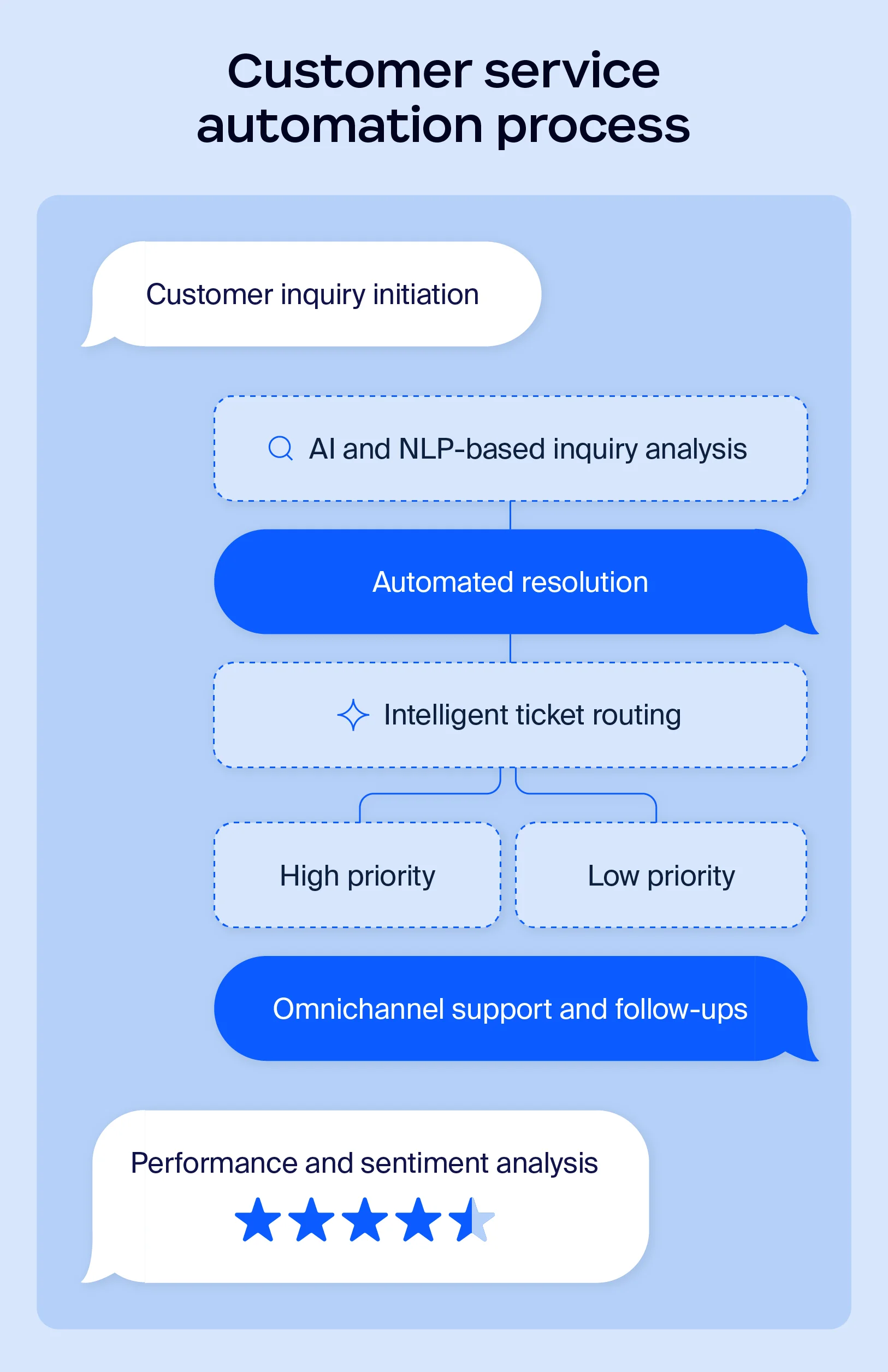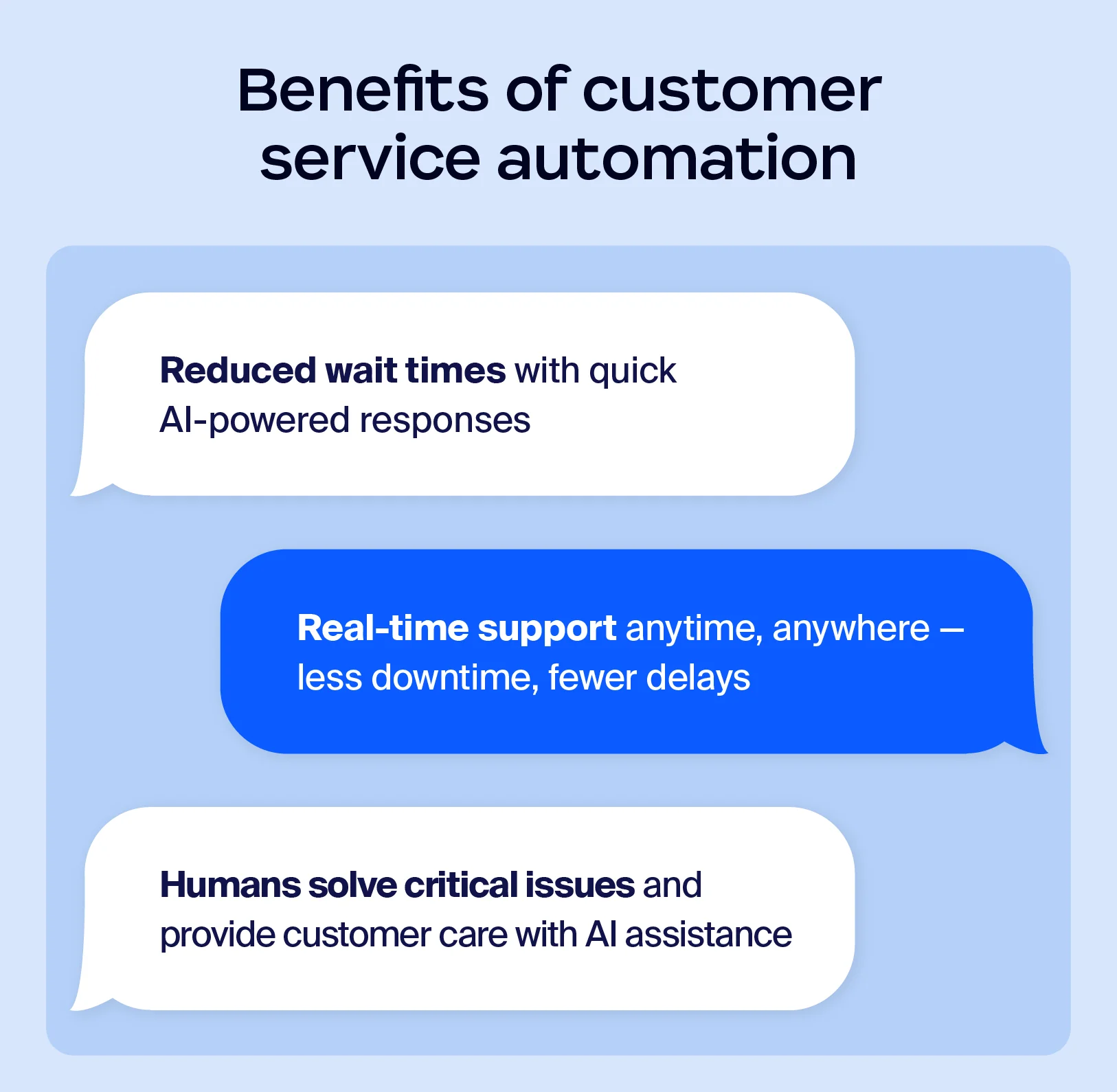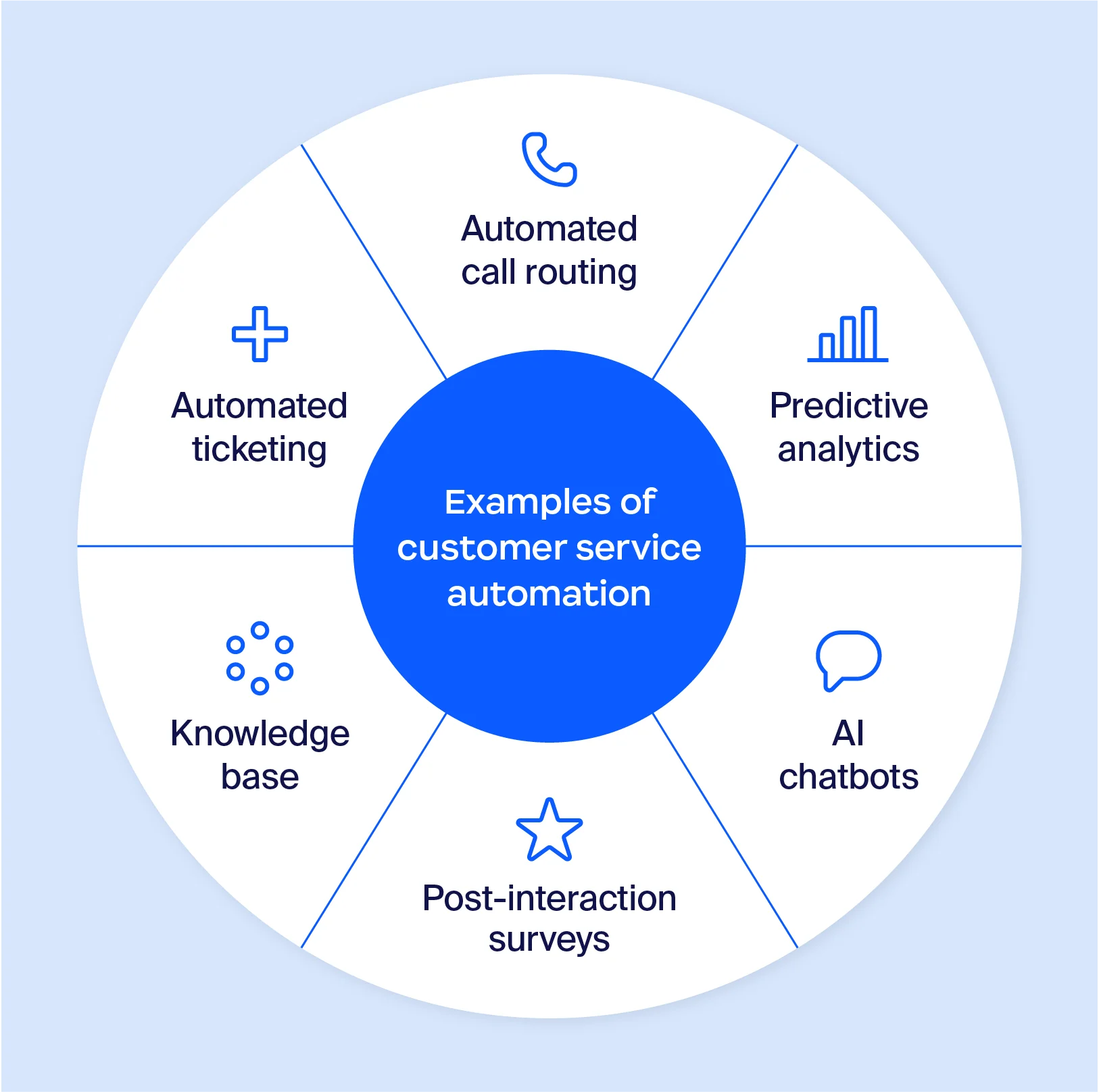
Meet Zoom AI Companion, your new AI assistant!
Boost productivity and team collaboration with Zoom AI Companion, available at no additional cost with eligible paid Zoom plans.
Updated on October 29, 2025
Published on March 31, 2025


As your business grows, so does customer demand. Customers expect fast response times, seamless interactions, and 24/7 availability, putting more pressure on support teams. In fact, customer experience statistics reveal that 65% of customers will switch to a competitor after one or two negative support experiences.
This is where automation comes in. The medium might change from tool to tool, and it can look very different, from dedicated automation tools to AI solutions. By speeding up responses and driving cost savings, automation is a powerful tool for shaping customer service processes.
In this guide, we’ll explore the benefits of customer service automation, the technologies behind it, and how tools like cloud contact centers, chatbots, and CRM integrations are reshaping the customer experience.
Customer service automation is the use of technology to simplify tasks, such as inquiry resolution, transaction processing, and customer data organization, without direct human involvement.
It relies on advanced technologies like AI, robotic process automation (RPA), and machine learning to drive smarter, more personalized interactions with customers.
Common customer service automation tools include:

Customer service automation leverages intelligent tools to streamline and simplify customer interactions, which allows businesses to resolve issues faster and provide immediate support. Here’s a closer look at how it works and the benefits it offers both customers and your team.
Automation enhances the customer experience by providing immediate and streamlined support, even when your team isn’t available. Here’s how it works:
When an issue can’t be immediately resolved, automated customer support software directs the customer to the appropriate next steps. This typically includes:
Automation delivers the context or relevant information from a customer interaction upfront. This allows support teams to resolve issues faster and more efficiently.

Good customer service requires speed and efficiency. Automating customer service frees up your team to focus on what really matters: serving your customers.
The customer service benchmark for live chat support is just 58 seconds for a first response. Automation can help your business act quickly on inquiries to meet or exceed these standards.
Chatbots can immediately handle FAQs, such as store hours or return policies, reducing the need for human intervention and allowing your business to manage high volumes of inquiries.
Similarly, automatic call distribution (ACD) systems quickly route customers to the appropriate agent. This reduces wait times to provide specialized support.
Automation allows customers access to support at any time, day or night.
AI for customer service, such as chatbots, can provide seamless assistance or empower customers to self-resolve issues if your team is not online to help. For instance, Zoom’s AI chatbot reinvented CX by successfully resolving 97% of customer conversations without ever needing a live agent.
Automation tools can also manage customer queries in multiple languages. By expanding to a wider, more diverse audience, it’s easier to support customers across different time zones and regions.
Automating routine inquiries, such as order tracking or password resets, helps reduce the burden on your team.
By offloading these tasks, agents can dedicate time to focus on more complex or high-priority issues. This includes addressing delicate customer concerns that require empathy or critical thinking.
Automation helps customers stay informed about changes or account updates in a timely manner. With proactive notifications, like updates on service outages or account modifications, you can better manage customer expectations.
Notifications can also include links to FAQs or self-service options that empower customers to resolve issues independently.
Real-time analytics allow you to track customer interactions to identify common issues and emerging service trends.
AI-powered tools, like Zoom AI Companion for Contact Center or Zendesk’s Answer Bot, take this further by predicting your needs and recommending actionable steps. For example, if a spike in product return requests is detected, AI can suggest process adjustments or proactive communication.
By leveraging data-driven insights, your business can optimize workflows, refine product offerings, and implement more effective strategies that drive greater customer satisfaction.

Customer service automation boosts efficiency for your team while elevating customer satisfaction. Here are some real-world examples showcasing how you can apply automation across different customer service contexts.
Automated systems categorize and prioritize incoming support tickets based on urgency and complexity. High-priority issues are then routed to specialized agents for quick resolution and a smoother customer experience.
Real-world example: An e-commerce platform uses automation to prioritize tickets. A customer experiencing payment issues is flagged as high-priority, while less urgent issues like product inquiries are categorized accordingly. This allows the support team to handle critical issues first and improves response times.
Automation uses skills-based call routing to direct customers to the appropriate person based on their request. Whether it’s directing calls to a specific department, matching product expertise, or accommodating language preferences, the system helps streamline this process.
Real-world example: A telecom company implements skills-based call routing to direct international customers to agents who speak their language. This helps reduce wait times so customers don’t have to be transferred multiple times, which leads to faster and more efficient resolutions.
According to CX trends, 85% of consumers say short wait times should be part of the support experience.
Interactive voice response (IVR) guides customers through self-service options to help them resolve simple tasks without needing to speak with an agent. By automating these responses, the system reduces call volume and directs customers to more personalized support.
Real-world example: A bank uses IVR to help customers check account balances or pay bills without human assistance. This frees up the agents to focus on more complex issues and improves overall service efficiency.
For businesses to serve diverse customers, automation tools provide multilingual support without requiring multiple support teams across all regions.
Real-world example: A global software company uses an AI chatbot capable of communicating in multiple languages. This delivers consistent support for customers in different countries while saving time and resources.
Intuitive, AI-driven assistants, like Zoom Virtual Agent, can handle complex customer inquiries by pulling up historical data and contextual understanding. It can offer more personalized support, resolve multiple issues in one interaction, and escalate the issue when needed.
Real-world example: An airline uses a virtual assistant to help passengers book flights, check flight status, and change bookings. If the issue is too complex, such as a flight cancellation, the chatbot quickly escalates the case to a human agent with all the relevant context.
To enhance customer satisfaction and internal efficiency, consider these best practices for your automation strategy.
Automation is most effective when it works in harmony with your existing systems, unifying and streamlining the customer experience.
By proactively gathering feedback and acting on the voice of the customer, you can continually improve the customer experience. Consider these strategies for leveraging feedback.
Customer-facing teams should be well-informed and trained on how to automate customer service. By being fully in the loop, they can maximize the benefits of automation while delivering exceptional service.
Ongoing monitoring helps automation align with your SMART customer service goals and adapt to changing needs.
While automation can drive efficiency, human intervention is essential to creating meaningful connections and ensuring that every customer feels valued and understood.
By following these best practices, your business can use the power of automation to streamline operations and create happier, more satisfied customers.
A future-ready contact center solution optimizes customer service operations with powerful automation, delivering seamless tools on a unified platform.
With AI-driven chatbots, automated ticket routing, and integrations across communication channels, Zoom Contact Center can empower your team to deliver seamless, highly personalized customer care.
Get answers to frequently asked questions about customer service automation, its technologies, and the benefits it offers.
Customer service automation provides data security through encryption, secure data storage, and access control. Automated systems typically adhere to industry standards and regulations, such as GDPR and CCPA, to protect sensitive customer information.
Customer service automation automates customer-facing tasks like inquiries, issue resolution, and ticket management to improve efficiency and enhance the customer experience.
CRM service automation, on the other hand, focuses on automating internal processes like tracking customer interactions and managing sales pipelines.
Artificial intelligence is one of the most common technologies for customer service automation. It can automate support tickets, generate answers to straightforward questions, and route more complex issues to human agents.
Other widely used technologies include robotic process automation for task automation and interactive voice response systems for call handling.
Automated tools can use language detection tools to identify the customer’s preferred language and adjust the support experience accordingly.
At Zoom, we support 17 languages and language variants. With multi-language campaigns, Zoom can automatically detect the user’s language based on their browser settings or the HTML lang attribute of the page.